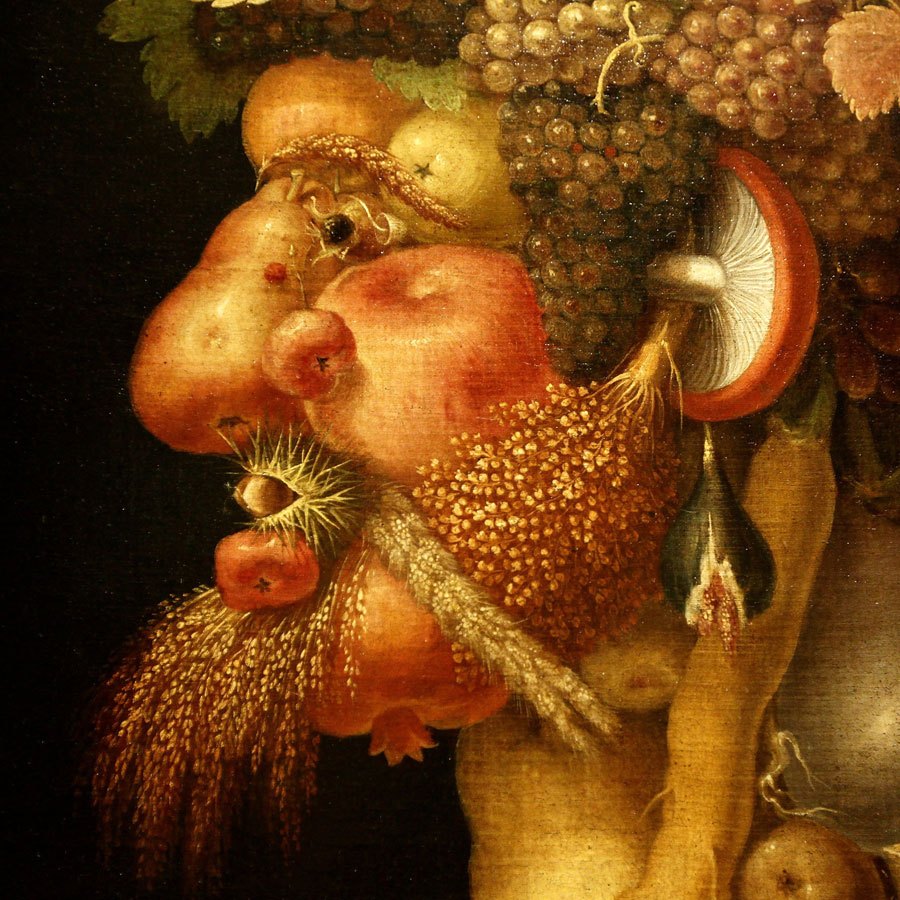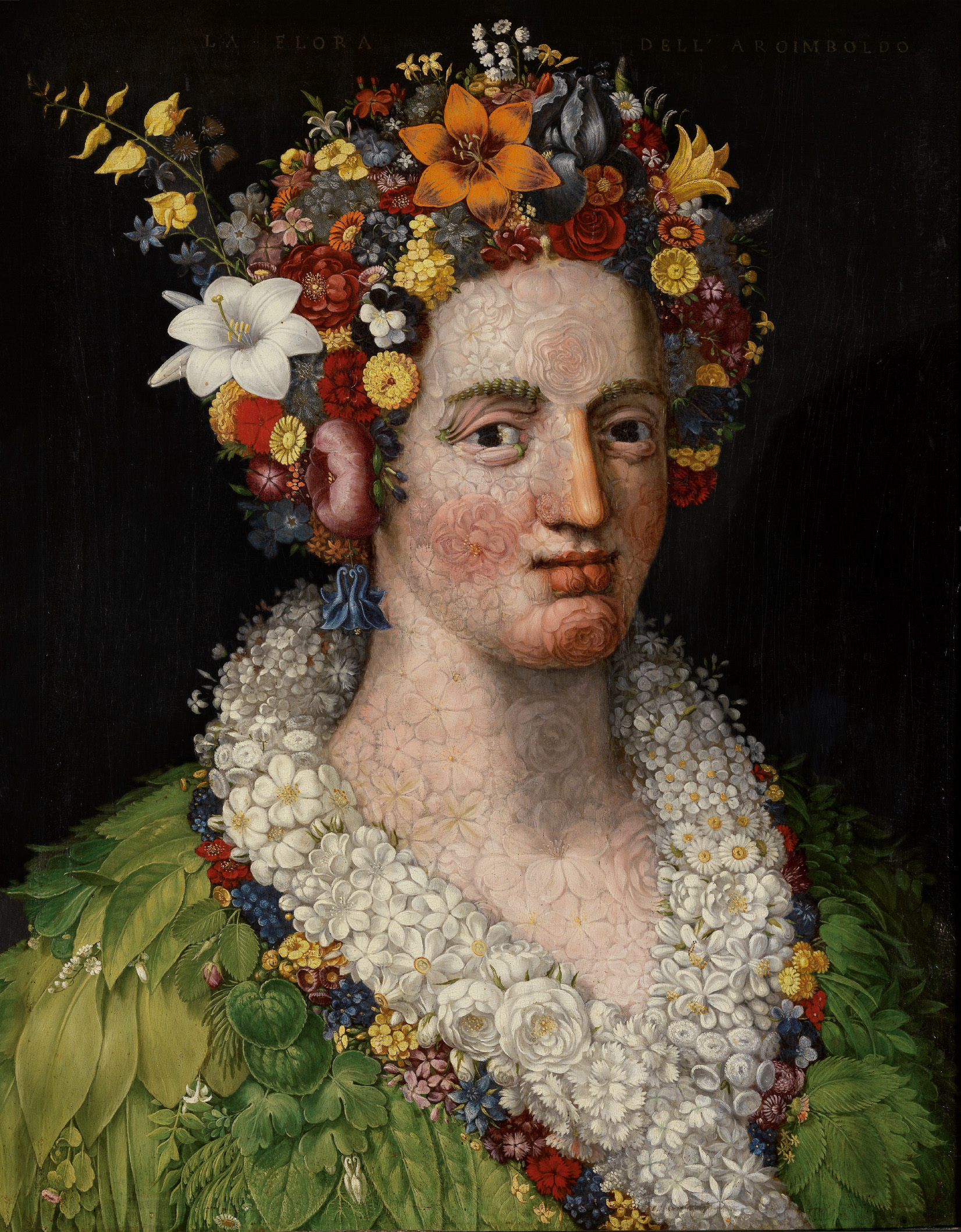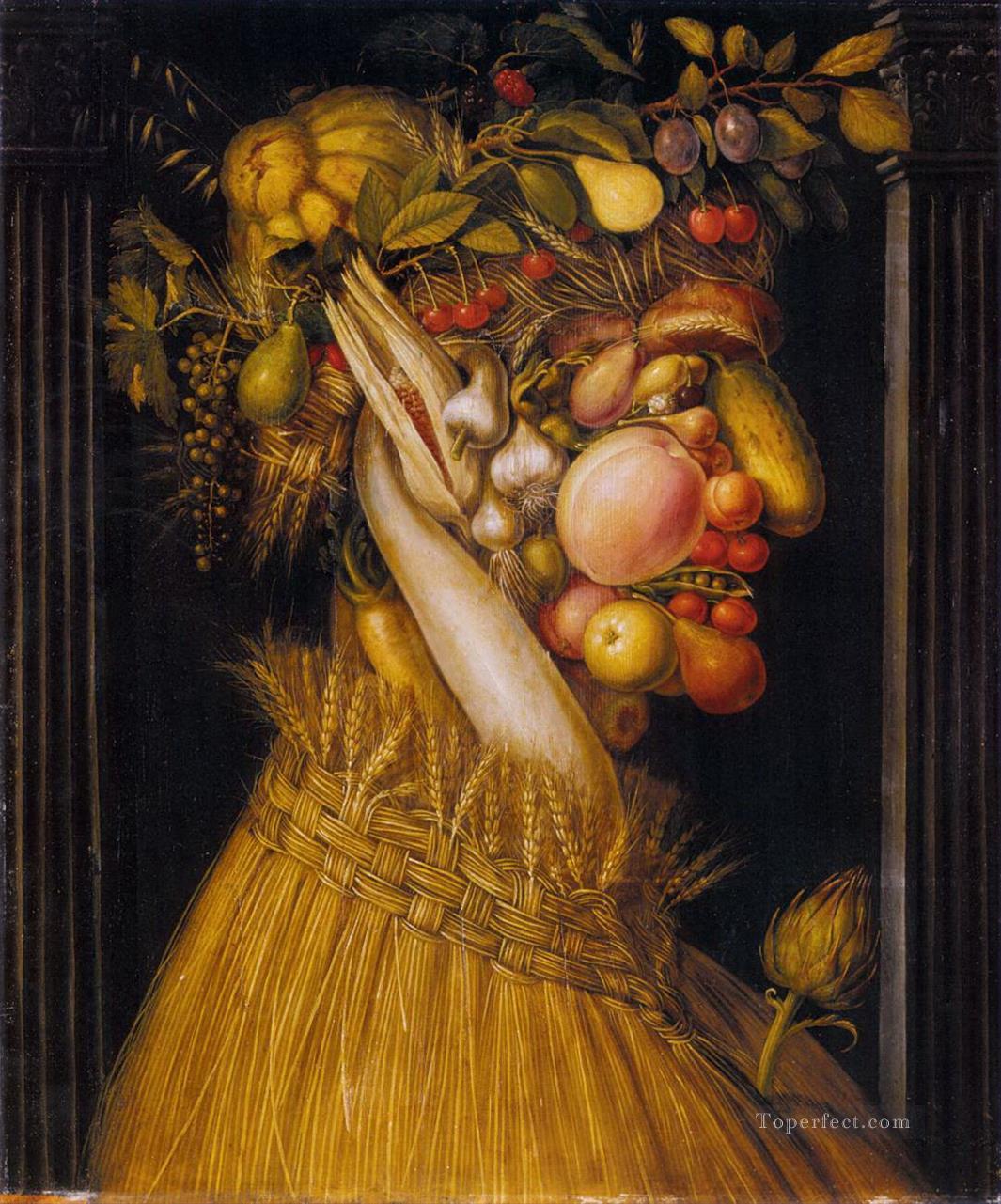
Giuseppe Arcimboldo (15261593) Catherine La Rose The Poet of Painting
The Seasons or The Four Seasons is a set of four paintings produced in 1563, 1572 and 1573 by the Italian artist Giuseppe Arcimboldo. He offered the set to Maximilian II, Holy Roman Emperor in 1569, accompanying The Four Elements. Each shows a profile portrait made up of fruit, vegetables and plants relating to the relevant season.

Arcimboldo_Autumn_1572 Giuseppe Arcimboldo, Renaissance Artists
giuseppe arcimboldo, Summer, 1563 introduction Anyone looking at Arcimboldo's composite heads for the first time feels surprised, startled, and bewildered; our gaze moves back and forth between the overall human form and the rich-ness of individual details until we get the joke and find ourselves amused, delighted, or perhaps even repelled.

Giuseppe Arcimboldo at the National Gallery of Art The New York Times
Giuseppe Arcimboldo Enquire Year Milan 1526 - 1593 Style Mannerism, Baroque Active region Italy: Lombardy - Prague Price range 1,000,000 - 3,000,000 USD +

Giuseppe Arcimboldo, the Renaissance Artist Whose FruitFaced Portraits
Giuseppe Arcimboldo Giuseppe Arcimboldo, also spelled Arcimboldi ( Italian: [dʒuˈzɛppe artʃimˈbɔldo]; [1] 5 April 1526 - 11 July 1593), was an Italian painter best known for creating imaginative portrait heads made entirely of objects such as fruits, vegetables, flowers, fish and books. [2]

Giuseppe ARCIMBOLDO Palette Art School Toronto, Thornhill, Concord
The attribution to Arcimboldo of the Metropolitan Museum drawing was first suggested by Giulio Bora (cited in Christie's sale catalogue, London, July 4, 1995, lot 37; see also Bora 1998 with its whereabouts listed as "già a Londra"), and was recently reaffirmed by Giuseppe Cirillo, as it is entirely convincing on the basis of style, technical evidence, and context of the documents here discussed.

Pin on Арчимбольдо, его предшественники и последователи
Giuseppe Arcimboldo was an Italian painter best known for creating imaginative portrait heads made entirely of objects such as fruits, vegetables, flowers, fish and books. These works form a distinct category from his other productions. He was a conventional court painter of portraits for three Holy Roman Emperors in Vienna and Prague, also.

Giuseppe arcimboldo spring art print by pdgraphics Artofit
P Paintings by Giuseppe Arcimboldo in the Kunsthistorisches Museum (4 C, 17 F) T The Daughters of Emperor Ferdinand I (series attributed to Arcimboldo - Kunsthistorisches Museum) (12 F) Pages in category "Paintings by Giuseppe Arcimboldo" This category contains only the following page. Paintings by Giuseppe Arcimboldo

Giuseppe Arcimboldo Allegories of the Elements, 1576 Tutt'Art
Few artists have painted portraits so beguiling as Giuseppe Arcimboldo, an Italian painter of the late Renaissance who made a name for himself in the courts of the Holy Roman Empire by creating.

Giuseppe Arcimboldo Paintings Gallery in Chronological Order
Painted singly or in series, the heads combine plants, animals, and other objects appropriate to the themes Arcimboldo treated, such as the Four Seasons and the Four Elements (earth, air, fire, and water). The artist's Four Seasons in One Head, newly acquired by the Gallery, was publicly presented for the first time in the Arcimboldo.

Giuseppe Arcimboldo Mannerist painter Tutt'Art Pittura
Giuseppe Arcimboldo was an Italian painter best known for creating imaginative portrait heads made entirely of such objects as fruits, vegetables, flowers, fish, and books - that is, he painted representations of these objects on the canvas arranged in such a way that the whole collection of objects formed a recognizable likeness of the.

Giuseppe Arcimboldo Man Of Fruits Canvas Print / Canvas Art by Pg
Giuseppe Arcimboldo Giuseppe (též Josephus/Josepho) Arcimboldo psal se i Acimboldi, Arcsimbaldo či Joseph Arsinwalda [1] ( 1527 Milán - 11. července 1593 Milán) byl italský malíř a dekoratér působící ve službách Habsburků na dvorech ve Vídni a v Praze.

Flora by Giuseppe Arcimboldo Obelisk Art History
Within a decade, Arcimboldo had made the jump from lighthearted whimsy to outlandish weirdness, with the first known composite heads presented to Maximilian on New Year's Day 1569. In 1590, Giuseppe Arcimboldo painted his royal patron, the Holy Roman Emperor Rudolf II, as a heap of fruits and vegetables. In any normal position severe.

Pin by Ольга Ли on Giuseppe Arcimboldo (1526 1593) Giuseppe
Giuseppe Arcimboldo was an Italian Renaissance painter known for his intricate paintings, which combined inanimate or found objects into a portrait that would resemble the portrait subject.

Spring By Giuseppe Arcimboldo Art Reproduction from Cutler Miles.
1 of 4 Art critic Jonathan Jones Summary of Giuseppe Arcimboldo Arcimboldo was an Italian Mannerist painter known for his extraordinary, and sometimes monstrous, human portraits. His unique collage style, which embodies a true surreal wit, is comprised of fruit and vegetables, animals, books, and other objects.

Giuseppe Arcimboldo (1526 1593) on Pinterest Portraits, Verano and
SAN JOSE — A man who has spent more than four years in jail fighting allegations he raped and killed his girlfriend's 2-year-old son is literally home free after a jury found him not guilty.

Summer Giuseppe Arcimboldo Fantasy Painting in Oil for Sale
Giuseppe Arcimboldo was an Italian Mannerist painter who was born in 1526 in Milan and died in 1593. He is best known for his imaginative human head portrait creations using inanimate objects, such as vegetables, books, fruits, animals and flowers. Said to be 400 years ahead of his time, his paintings were considered to be incredibly modern.